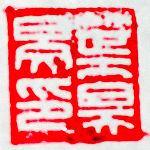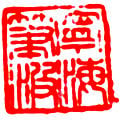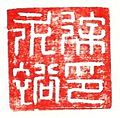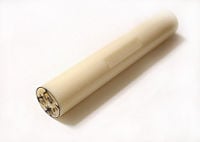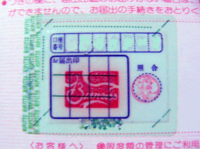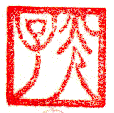Seal (East Asia)
| Seal (East Asia) | |||||||
|---|---|---|---|---|---|---|---|
|
| |||||||
| Chinese name | |||||||
| Traditional Chinese: | 印鑑 or 圖章 | ||||||
| Simplified Chinese: | 印章 | ||||||
| |||||||
| Japanese name | |||||||
| Kanji: | 判子 or 印鑑 or 印章 | ||||||
| Romaji: | hanko or inkan or inshō | ||||||
| Korean name | |||||||
| Hangul: | 도장 or 인장 or 인감 | ||||||
| Hanja: | 圖章 or 印章 or 印鑑 | ||||||
| |||||||
A Seal, in an East Asian context, is a general name for printing stamps and impressions thereof that are used in lieu of signatures in personal documents, office paperwork, contracts, art, or any item requiring acknowledgment or authorship. China, Japan, and Korea currently use a mixture of seals and hand signatures, and increasingly, electronic signatures.
Seals are typically made of stone, sometimes of wood, bamboo, plastic, or ivory, and are typically used with red ink or cinnabar paste (Chinese: 朱砂; pinyin: zhūshā). The word 印 ("yìn" in Mandarin, "in" in Japanese and Korean) specifically refers to the imprint created by the seal, as well as appearing in combination with other ideographs in words related to any printing, as in the Japanese word "insatsu" (printing).
Seal began about eleventh century B.C.E. during Shang Dynasty or Yin Dynaty (c. 1700 - 1046 B.C.E.), China. Seal developed as a part of its culture in each of Far Eastern countries of China, Japan, and Korea. Material components, shapes, sizes, scripts developed along with the development of political system as well as cultural developments of each country.
History
The use of seal in Asia began in the eleventh century B.C.E. during Shang Dynasty (Chinese: 商朝) or Yin Dynasty (殷代) (c. 1700 - 1046 B.C.E.), China. Copper seal in various sizes were excavated. During Warring States Period (476 B.C.E. - 221 B.C.E.), seals were made mostly of copper, and some were made of silver and stone. Seals were used for letters and documents between feudal lords and subjects, commercial transactions. Seals were also used to stamp on clay seal on wooden or bamboo letters. In addition to letters, images of animals and other natural objects were also used. Image seals gradually disappeared by sixth century in China. In Japan, it became popular during fifteenth and sixteenth century.
Qin Shi Huang (Chinese: 秦始皇; pinyin: Qín Shǐhuáng; Wade-Giles: Ch'in Shih-huang) (259 B.C.E. – 210 B.C.E.) of Qin Dynasty (778 B.C.E.-207 B.C.E.) established a sealing system and used it as an official signature of all public documents. Size, shape, material components were determined by ranks, and natures of the seal. Seal script also developed during the Qin Dynasty.
During the Sui Dynasty (Chinese: 隋朝; pinyin: Suí cháo; 581-618 C.E.), paper became popular and seal was used to stamp on paper documents. During Tang Dynasty (Chinese: 唐朝; pinyin: Táng Cháo; Middle Chinese: dhɑng) (June 18, 618 – June 4, 907), seal was recognized as works of art as well as practical authentication tools.
In Japan, it is recorded in Nihon Shoki that a wooden seal was offered to Tenno. It is believed that the seal was used for religious ceremonies. The oldest surviving seal in Japan is a golden seal given by Emperor Guangwu of Han (January 13, 5 B.C.E. - March 29, 57) to Japanese emperor. The seal was excavated in 1784 at Kyusyu prefecture of Japan. Official sealing system was established during Taika Reform (seventh century) along with the formation of Ritsuryō bureaucratic system of the government. In 1873, Japanese government legalized the use of particular type of seal (Jitsu in see below for explanation) for all legal documents. The Meiji government also attempted to adopt signature as a legitimate form of authentication following Western customs. Signature system, however, did not receive social acceptance and the government abandoned it.
In Korea, the seal was first introduced from China in approximately second century B.C.E. The remaining oldest record of its usage in Korea is that Kings of Buyeo used royal seal (oksae: 옥새, 玉璽) which had inscription of "Seal of the King of Ye" (濊王之印, 예왕지인). The use of seals became popular in Three Kingdoms period.
In China, Japan, and Korea, seal has been used as the primary authentication system to this day.
Types
- Zhuwen (shu bun in Japanese)(S:朱文, lit. "red characters") seals imprint the Chinese characters in red ink, sometimes referred to as yang seals.
- Baiwen (haku bun in Japanese) (S:白文, lit. "white characters") seals imprint the background in red, leaving white characters, sometimes referred to as yin seals.
- Zhubaiwen Xiangjianyin (S:朱白文相間印, lit. "red-white characters combined seal") seals use zhuwen and baiwen together
Government authorities
Emperors of China, their families and officials used large seals known as Xǐ (璽), which corresponds to the Great Seals of Western countries. Xǐ were usually made of jade (although hard wood or precious metal could also be used), and were originally square in shape. They were changed to a rectangular form during the Song Dynasty, but reverted to square during the Qing Dynasty, and officially renamed bǎo (寶, "treasure"). The Forbidden City in Beijing currently has a collection of 25 bǎo from the Qing Dynasty.
These seals typically bore the titles of the offices, rather than the names of the owners. Different seals could be used for different purposes: for example, Emperor Qianlong had a number of appreciation seals [乾隆御覽之寶] used on select paintings in their collection.
The most important of these seals was the Heirloom Seal, which was created by the first Emperor of China, Qin Shihuang, and was seen as a legitimising device embodying or symbolizing the Mandate of Heaven. The Heirloom Seal was passed down through several dynasties, but was lost by the beginning of the Ming Dynasty.
The most popular style of script for government seals in the imperial ages of China (from Song to Qing) is the jiudie wen ("ninefold script"), a highly stylized font which is unreadable to the untrained.
The government of the Republic of China (Taiwan) has continued to use traditional square seals of about 13 centimeters (5.12 inches) each side, known by a variety of names depending on the user's hierarchy. Part of the inaugural ceremony for the President of the Republic of China includes bestowing on him the Seal of the Republic of China and the Seal of Honor.
The seal of state of the People's Republic of China[1] is a square, bronze seal with side lengths of 9 centimetres (3.54 inches). The inscription reads "Seal of the Central People's Government of the People's Republic of China." Notably, the seal uses the relatively modern Song typeface rather than the more ancient seal scripts, and the seal is called a yin (印), not a xi (玺), in a nod to modernity. Ordinary government seals in the People's Republic of China today are usually circular in shape, and have a five-pointed star in the centre of the circle. The name of the governmental institution is arranged around the star in a semi-circle.
Personal
There are many classes of personal seals:
Name 名印
Denotes the person's name. These are almost always square.
| Name (Chinese) | Name (Pinyin) | English name | Example | Use |
|---|---|---|---|---|
| 姓名印 | Xingming Yin | Personal Name Seal | [李小狼] or [李小狼印] | State the family and personal name of a person |
| 表字印 | Biaozi Yin | Style Name Seal | [字矗昊] or [矗昊] | State the style name of a person |
| 臣妾印 | Chenqie Yin | Subject Concubine Seal | [臣小明] (male) [妾美櫻] (female) |
Used in imperial times by imperial consorts or officials |
| 書簡印 | Shujian Yin | Simplified Word Seals | [如佩信印] | Used in letters, instead of writing well wishes by hand, the seal takes its place |
| 總印 | Zong Yin | General or Combined Seal | [大英伯明皇龍正之章] | States the personal name and the place name where he/she is from |
| 迴文印 | Huiwen Yin | Rotating Character Seal | [徐永裕印] | Same as the personal name seal, but characters are read in an anti-clockwise direction, rather than from the top-down, right-to-left. Sometimes used in writing (i.e. to sign a preface of a book, etc). |
Free 閑印
Are the equivalent of today's online signatures, and can contain the person's personal philosophy or literary inclination. These can be any shape, ranging from ovals to dragon-shaped.
| Name (Chinese) | Name (Pinyin) | English name | Example | Use |
|---|---|---|---|---|
| 肖形印 | Xiaoxing Yin | Portrait Seal | N/A | Has images with no words to express the user's character |
| 吉語印 | Jiyu Yin | Lucky Sayings Seal | [日就富貴] | Has lucky sayings and proverbs |
| 黃神越章 | Huangshen Yuezhang | Exceeding Seal of the Yellow God | [黃神越章天帝神之印] | Used in ancient times on letters as a protective charm on letters to ward off wild beasts and demons of the recipient. Now used mainly as a well-wishing convention on letters to people who travel abroad. |
| 封泥 | Feng Ni | Sealing Stamp | N/A | Used to seal letters or packages, often after the sealing tag/strip has been stuck on the flap |
Studio 齋印
Carry the name of the person's private studio 書齋, which most literati in ancient China had, although probably in lesser forms. These are more or less rectangular in shape.
| Name (Chinese) | Name (Pinyin) | English name | Example | Use |
|---|---|---|---|---|
| 齋館印 | Zhaiguan Yin | Studio or Study Seal | [雅目齋] | States the name of the studio or body. This includes society and company seals |
| 別號印 | Biehao Yin | Alias Seal | [白石道人] | States aliases that the user uses. These include artistic names, painting names, pen-names, etc |
| 收藏印 | Shoucang Yin | Storage Seal | [松雨彗齋圖書印] | Used on books or paintings that are kept by the user. This includes appreciation seals used on paintings and books that the owner admires |
| 詞句印 | Ciju Yin | Poetry Seal | [問松消息] | Has poems or proverbs inscribed, used on paintings, etc. Size can range from big to small depending on how long the inscription is |
| 花押印 | Huaya Yin | Flower Signature Seal | N/A | A mark used in place of a signature. Often small, sometimes with images, the design can be varied in style, often a stylization of a single Chinese character |
Seal paste
There are two types of seal paste depending on what base material they are made of.
- Silk: The red paste is made from finely pulverized cinnabar, mixed with castor oil and silk strands. The silk strands bind the mixture together to form a very thick substance. It has a very oily appearance and tends to be a bright red in color.
- Plant: The red paste is made from finely pulverized cinnabar, mixed with castor oil and moxa punk. Because the base is a plant one that has been pulverised, the texture is very loose due to the fact that it doesn't bind. The appearance is sponge like and not oily and tends to be a darker shade of red.
Plant-based paste tends to dry more quickly than silk-based pastes because the plant extract does not hold onto the oil as tightly as silk. Depending on the paper used, plant pastes can dry in 10 to 15 minutes. The more absorbent the paper is, the faster it dries as the paper absorbs most of the oil. Also, plant pastes tend to smudge more easily than silk pastes due to the loose binding agent.
The paste is kept covered after it has been used, in its original container (be it plastic or ceramic). It is kept in an environment away from direct sunlight and away from intense heat to prevent it from drying out.
When the seal is pressed onto the printing surface, the procedure differs according to plant or silk based paste. For silk based paste, the user applies pressure, often with a specially made soft, flat surface beneath the paper, and rocks it forward and back, left and right slightly. For plant based paste, the user simply applies light pressure. As lifting the seal vertically away from its imprint may rip or damage paper, the seal is usually lifted off one side at a time, as if bent off from the page. After this, the image may be blotted with a piece of paper to make it dry faster, although this may smudge it.
Chinese usage
Most people in China possess a personal name seal. Artists, scholars, collectors and intellectuals may possess a full set of name seals, leisure seals, and studio seals. A well-made seal made from semi-precious stones can cost typically between 400 Chinese yuan (59 US dollars) and 4,000 Chinese yuan (585.4 US dollars).
Seals are still used for official purposes in a number of contexts. When collecting parcels or registered post, the name seal serves as an identification, akin to a signature. In banks, traditionally the method of identification was also by a seal. Seals remain the customary form of identification on cheques in Mainland China and Taiwan but not in Hong Kong where signatures are required. Today, personal identification is often by a hand signature accompanied by a seal imprint. Seals can serve as identification with signatures because they are difficult to forge (when compared to forging a signature) and only the owner has access to his own seal.
Seals are also often used on Chinese calligraphy works and Chinese paintings, usually imprinted in such works in the order (from top to bottom) of name seal, leisure seal(s), then studio seal. Owners or collectors of paintings or books will often add their own studio seals to pieces they have collected. This practice is an act of appreciation towards the work. Some artworks have had not only seals but inscriptions of the owner on them; for example, the Qianlong emperor had as many as 20 different seals for use with inscriptions on paintings he collected. Provided that it is tastefully done (for example, not obscuring the body of the painting, appropriate inscription, fine calligraphy, etc), this practice does not devalue the painting.
Seals are usually carved out by specialist seal carvers, or by the users themselves. Specialist carvers will carve the user's name into the stone in one of the standard scripts and styles described above, usually for a fee. On the other hand, some people take to carving their own seals using soapstone and fine knives, which are widely available and is cheaper than paying a professional for expertise, craft, and material. Results vary, but it is possible for individuals to carve perfectly legitimate seals for themselves.
As a novelty souvenir, seal carvers also ply tourist business at Chinatowns and tourist destinations in China. They often carve on-the-spot or translations of foreign names on inexpensive soapstone, sometimes featuring Roman characters. Though such seals can be functional, they are typically nothing more than souvenirs or ornaments.
Determining which side of the seal should face up may be done in a number of ways: if there is a carving on top, the front should face the user; if there is an inscription on the side, it should face to the left of the user; if there is a dot on the side, it should face away from the user.
Once seals are used, as much paste as possible is wiped from the printing surface and the edges off with a suitable material. The seals are kept in a constant environment, especially seals made of sandalwood or black ox horn. Tall thin seals are best kept on their sides, in case it should wobble and fall down. More important seals, such as authority and society seals are encased or wrapped in a golden silk cloth to add more protection.
Japanese usage
General
In Japan, seals in general are referred to as inkan (印鑑) or hanko (判子). Inkan is the most comprehensive term; hanko tends to refer to seals used in less important documents.
Government offices and corporations usually have inkan specific to their bureau or company, and which follow the general rules outlined for jitsu in with the following exceptions. In size, they are comparatively enormous, measuring two to four inches across. Their handles are often extremely ornately carved with friezes of mythical beasts or hand-carved haku bun inscriptions that might be quotes from literature, names and dates, or original poetry. Some have been carved with square tunnels from handle to underside, so that a specific person can slide his own inkan into the hollow, thus signing a document with both his own name and his business's (or bureau's) name. These seals are usually stored in jitsu in-style boxes under high security except at official ceremonies, at which they are displayed on extremely ornate stands or in their boxes.
Main types
For personal use, there are at least four kinds of seals. In order from most formal/official to least, they are: 'Jitsu in', 'Ginko in', 'Mitome in', and 'Gago in'.
A 'jitsu in' (実印) is an officially registered seal. A registered seal is needed to conduct business and other important or legally binding events. A jitsu in is used when purchasing a vehicle, marrying, purchasing land, and so on.
The size, shape, material, decoration, and lettering style of jitsu in are closely regulated by law. For example, in Hiroshima, a jitsu in is expected to be roughly 1/2 inch to 1 inch wide, usually square or (rarely) rectangular but never round, irregular, or oval, and must contain the individual's full family and given name, without abbreviation. The lettering must be red with a white background (shu bun), with roughly equal width lines used throughout the name. The font must be one of several based on ancient historical lettering styles found in metal, woodcarving, and so on; ancient forms of ideographs are commonplace. A red perimeter must entirely encircle the name, and there should be no other decoration on the underside (working surface) of the seal, though the top and sides (handle) of the seal may be decorated in any fashion from completely undecorated to historical animal motifs to dates, names, and inscriptions.
Throughout Japan, rules governing jitsu in design are so stringent and each design so unique that the vast majority of people entrust the creation of their jitsu in to a professional, paying upward of US$20 and more often closer to US$100, and will use it for decades. People desirous of opening a new chapter in their lives—say, following a divorce, death of a spouse, a long streak of bad luck, or a change in career—will often have a new jitsu in made.
Several magazines are published for collectors, hobbyists, and professionals.
The material is usually a high quality hard stone, and far less frequently deerhorn, soapstone, or jade. It's sometimes carved by machine. When it's carved by hand, an in tou ("seal blade"), a mirror, and a small specialized wooden vice are used. An in tou is a flat-bladed pencil-sized chisel, usually round or octagonal in cross-section and sometimes wrapped in string to give the handle a non-slip surface. The in tou is held vertically in one hand, with the point projecting from one's fist on the side opposite one's thumb. New, modern in tou range in price from less than US$1 to US$100.
The jitsu in is always kept in a very secure place such as a bank vault or hidden carefully in one's home. They're usually stored in thumb-sized rectangular boxes made of cardboard covered with heavily embroidered green fabric outside and red silk or red velvet inside, held closed by a white plastic or deerhorn splinter tied to the lid and passed through a fabric loop attached to the lower half of the box. Because of the superficial resemblance to coffins, they're often called "coffins" in Japanese by enthusiasts and hanko boutiques. The paste is usually stored separately.
A 'ginko in' is used specifically for banking; ginko means "bank." A person's savings account passbook contains an original impression of the ginko in alongside a bank employee's seal. Rules for the size and design vary somewhat from bank to bank; generally, they contain a Japanese person's full name; a Westerner may be permitted to use a full family name with or without an abbreviated given name, such as "Smith," "Bill Smith," "W Smith" or "Wm Smith" in place of "William Smith." The lettering can be red or white, in any font, and with artistic decoration.
Most people have them custom-made by professionals or make their own by hand, since mass-produced ginko in would offer zero security. They are usually stone and carried about in a variety of thumb-shaped and -sized cases resembling cloth purses or plastic pencil cases. They are usually hidden carefully in the owner's home.
Banks always provide stamp pads or ink paste, in addition to dry cleansing tissues. The banks also provide small plastic scrubbing surfaces similar to small patches of red artificial grass. These are attached to counters and used to scrub the accumulated ink paste from the working surface of customers' seals.
A 'mitome-in' (認印) is a moderately formal seal typically used for signing for postal deliveries, signing utility bill payments, signing internal company memos, confirming receipt of internal company mail, and other low-security everyday functions.
Mitome in are commonly stored in low-security, high-utility places such as office desk drawers and in the anteroom (genkan) of a residence.
The mitome in always has the person's family name, and usually does not have the person's first name. It is often round or oval, but square ones are not uncommon, and rectangular ones are not unheard-of. They are always regular geometric figures. They can have red lettering on a blank field (shu bun) or the opposite (haku bun). Borderlines 'round their edges are optional.
Plastic ones in popular Japanese names can be obtained from stationery stores for less than US$1, though mitome in made from inexpensive stone are also very popular. Prefabricated rubber stamps are unacceptable for business purposes.
Mitome in and lesser seals are usually stored in inexpensive plastic cases, sometimes with small supplies of red paste or a stamp pad included.
Most Japanese also have a far less formal seal used to sign personal letters or initial changes in documents; this is referred to by the also broadly generic term hanko. They often display only a single hiragana, kanji ideograph, or katakana character carved in it, They are as often round or oval as they are square. They vary in size from 0.5 to 1.5 cm (0.2 to 0.6 inches) wide; women's tend to be small.
'Gago in' are used by graphic artists to both decorate and sign their work. The practice goes back several hundred years. The signatures are frequently pen names or nicknames; the decorations are usually favorite slogans or other extremely short phrases. A gago in can be any size, design, or shape. Irregular naturally occurring outlines and handles, as though a river stone were cut in two, are commonplace. The material may be anything, though in modern times soft stone is the most common and metal is rare.
Traditionally, inkan and hanko are engraved on the end of a finger-length stick of stone, wood, bone, or ivory, with a diameter between 25 and 75 millimetres (1 and 3 in). Their carving is a form of calligraphic art. Foreign names may be carved in rōmaji, katakana, hiragana, or kanji. Inkan for standard Japanese names may be purchased prefabricated.
Almost every stationery store, five-and-dime store, large book store, and department store carries small do-it-yourself kits for making hanko. These include instructions, hiragana fonts written forward and in mirror-writing (as they'd appear on the working surface of a seal), a slim in tou chisel, two or three grades of sandpaper, slim marker pen (to draw the design on the stone), and one to three mottled, inexpensive, soft square green finger-size stones.
In modern Japan, most people have several inkan.
A certificate of authenticity is required for any hanko used in a significant business transaction. Registration and certification of an inkan may be obtained in a local municipal office (e.g. city hall). There, a person receives a "certificate of seal impression" know as inkan tōroku shōmei-sho (印鑑登録証明書).
The first evidence of writing in Japan is a hanko dating from AD 57, made of solid gold and belonging to the Emperor. At first, only the Emperor and his most trusted vassals held hanko, as they were a symbol of the Emperor's authority. Noble people began using their own personal hanko after 750, and samurai began using them sometime in the Middle Ages. Samurai were permitted exclusive use of red ink. After modernization began in 1870, hanko finally came into general use throughout Japanese society.
The increasing ease with which modern technology allows hanko fraud is beginning to cause some concern that the present system will not be able to survive.
Privy seal of Japan

The Privy Seal of Japan is the Emperor of Japan's official seal. It is square and its inscription "天皇御璽" is written in the seal script (篆書:tensho). It has two lines of vertical writing. On the right-hand side is "天皇" (Tenno) and on left-hand side is "御璽" (Gyoji). The seal is printed on appointment documents, such as proclamation sentences of a law, government ordinances, treaties, instruments of ratification, ambassadors' credentials, documents from the Prime Minister or Chief Justice and also on written appointments of dismissal.
The history of the Privy Seal of Japan goes back to the Nara period. Although it was originally made from copper, it was manufactured from stone in 1868 (Meiji) and later, was made from pure gold. The present Privy Seal is pure gold and is about 3 sun (about 9 cm; 3.5 inches) in size and weighs 4.5kg (9.9 pound). The master-hand of the seal lived in Kyoto, 安部井 櫟堂 (Abei Rekido 1805-1883). He was commissioned to manufacture the State Seal of Japan in one year in 1874 (Meiji 7). When not in use, the seal is kept in a leather bag. The seal is used with special cinnabar seal ink specially made in the National Printing Bureau.
If the State Seal or the Privy Seal are illegally reproduced, the penalty is at least two years of penal servitude according to Article 164 the first clause of the criminal code.
State seal of Japan

The Country Seal of Japan (Japanese: 国璽, formerly 國璽 kokuji) is the Japanese official seal of state. It is cubic. The characters 大日本國璽 (Great Japan Nation Seal) are carved in it in the Archaic script (篆書 tensho). When written vertically in two lines, the right-hand side is 大日本 (Dai Nippon) and the left-hand side is "國璽"(Kokuji).
The seal is made from pure gold, measures 3 suns (about 9cm; 3.5 inches) and weighs 4.5kg (9.9 pound). Abei Rekido, the Kyoto-based master-hand of the seal, (安部井 櫟堂, 1805-1883) was ordered to produce the seal, and he manufactured it with the Privy Seal of Japan in one year in 1874. Although there was no character of "帝" (imperial) into the seal sentence since it was manufactured before the name of a country of Japan was formally known as 大日本帝国 (Dai Nippon Teikoku) by the Meiji Constitution, it was not reminted at the time of the Meiji Constitution establishment. Under the Meiji Constitution, the case where the Privy Seal or State Seal is pushed had been defined on the official note formula (公文式: kōbunshiki 1886-1907) and the official formula code (公式令: kōreisiki 1907-1947). However, the code was abolished with enforcement of the Constitution of Japan, and there is currently no replacement statute. The State Seal is only used for certificate decoration (勲記: kunki).
It is stored in a specially designated leather bag. When used, a special ruler is used, and cinnabar seal ink specially made in the national Printing Bureau is used so that it should not bend or shift.
Reproduction of the State Seal and the Privy Seal for unauthorized purposes are offenses, punishable by two years or more of terminable penal servitude according to Article 164 the first clause of the criminal code.
Korean usage
In case of State Seals in monarchic Korea, there were two types of it in use: Gugin (국인, 國印) which was conferred by the Emperor of China to Korean kings, in sense of keeping relations between two countries as brothers(Sadae-jui). This was used only in communications with China and coronation of kings. Others, generally called eobo (어보, 御寶) or eosae (어새, 御璽), are used in foreign communications with countries other than China, and domestic uses. With declaration of establishment of Republic of Korea in 1948, its government created a new State Seal, guksae (국새, 國璽) and it is used in promulgation of constitution, designation of cabinet members and ambassadors, conference of national orders and important diplomatic documents. Seals were also used by government officials in documents. These types of seals were called gwanin (관인, 官印) and it was supervised by specialist officials.
In traditional arts, like China and Japan, an artist of Chinese calligraphy and paintings would use their seals (generally leisure seals and studio seals) to identify his/her work. These types of seals were called Nakkwan (낙관, 落款). As seal-carving itself was considered a form of art, many artists carved their own seals. Seals of Joseon-period calligraphist and natural historian Kim Jung-hee (aka Wandang or Chusa) are considered as antiquity.
In modern Korea, the use of seals is still common. Most Koreans have personal seals, every government agency and commercial corporation has its own seals to use in public documents. While signing is also accepted, many Koreans think it is more formal to use seals in public documents.
Personal seals (dojang in general reference) in Korea can be classified by their legal status. It is very similar to that of Japan: ingam (인감, 印鑑) or sirin (실인, 實印), meaning registered seal, is the seal which is registered to local office. By registering the seal, a person can issue a "certificate of seal registration" (ingam-jungmyeong-seo (인감증명서, 印鑑證明書) in Korean) which is required documents for most of significant business transactions and civil services. While ingam is used in important business, other dojangs are used in everyday purpose such as less-significant official transactions. Thus most Koreans have more than two seals.
Korean seals are made of wood, jade, or sometimes ivory for more value. State Seals were generally made of gold or high-quality jade. Rare cases of bronze or steel seals are remaining.
Other usage
While Chinese seals are typically used in China, Japan and Korea, it could be occasionally used outside these countries. For example, the rulers of the Ilkhanate, a Mongol khanate established by Hulagu Khan in Persia, used seals containing Chinese characters in each of their diplomatic letters, such as the letter from Arghun to French King Philip IV and the letter from Ghazan to Pope Boniface VIII. These seals were sent by the emperors of the Yuan Dynasty, a ruling dynasty of China and Mongolia, especially Kublai Khan and his successor Emperor Chengzong.
See also
- Seal (device)
Notes
- ↑ 图文:毛主席亲手定印文—新中国的“开国之玺”. Retrieved February 7, 2009.
ReferencesISBN links support NWE through referral fees
- Bai, Qian-shen. The World Within a Square Inch: The Art of Chinese Seal Carving. [New Haven, Conn.]: Yale University Art Gallery, 1992.
- Bowes, James Lord. Japanese Marks and Seals: In Literature and the Arts. [S.l.]: Floating World Editions, 2003. ISBN 9781891640117
- Kuo, Jason C. Word As Image: The Art of Chinese Seal Engraving. New York City: China House Gallery, 1992. ISBN 9780295972534
- Lai, T. C. Chinese Seals. Seattle: University of Washington Press, 1976. ISBN 9780295955179
- Masujima, Rokuichirō. 1889. "On the Jitsuin or Japanese Legal Seal." Transactions. 17:.
- Rhee, Hyoung Koo. The History of Chinese Seals. Thesis (M.A.)—University of Iowa, 1991, 1991.
- Sun, Weizu. Chinese Seals: Carving Authority and Creating History. San Francisco: Long River Press, 2004. ISBN 9781592650132
- Taguchi, Nishū. Tenkoku, the Seal Engraving; From Hieroglyphs to Alphabet. [Rutland, Vt.]: Japan Publications Trading Co, 1964.
- Tzannes, Robin, Zeng Xianwen, and Mitchel Chalek. The Art of Chinese Chops. San Francisco: Chronicle Books, 2003. ISBN 9780811835831
External links
All links retrieved August 25, 2015.
- The Art of Chinese Chop (Seal Carving)
- History of Chinese Seal Carvings
- Art-Virtue.com History of Chinese seal making
- Introduction to Chinese Seal Carving
Credits
New World Encyclopedia writers and editors rewrote and completed the Wikipedia article in accordance with New World Encyclopedia standards. This article abides by terms of the Creative Commons CC-by-sa 3.0 License (CC-by-sa), which may be used and disseminated with proper attribution. Credit is due under the terms of this license that can reference both the New World Encyclopedia contributors and the selfless volunteer contributors of the Wikimedia Foundation. To cite this article click here for a list of acceptable citing formats.The history of earlier contributions by wikipedians is accessible to researchers here:
The history of this article since it was imported to New World Encyclopedia:
Note: Some restrictions may apply to use of individual images which are separately licensed.
